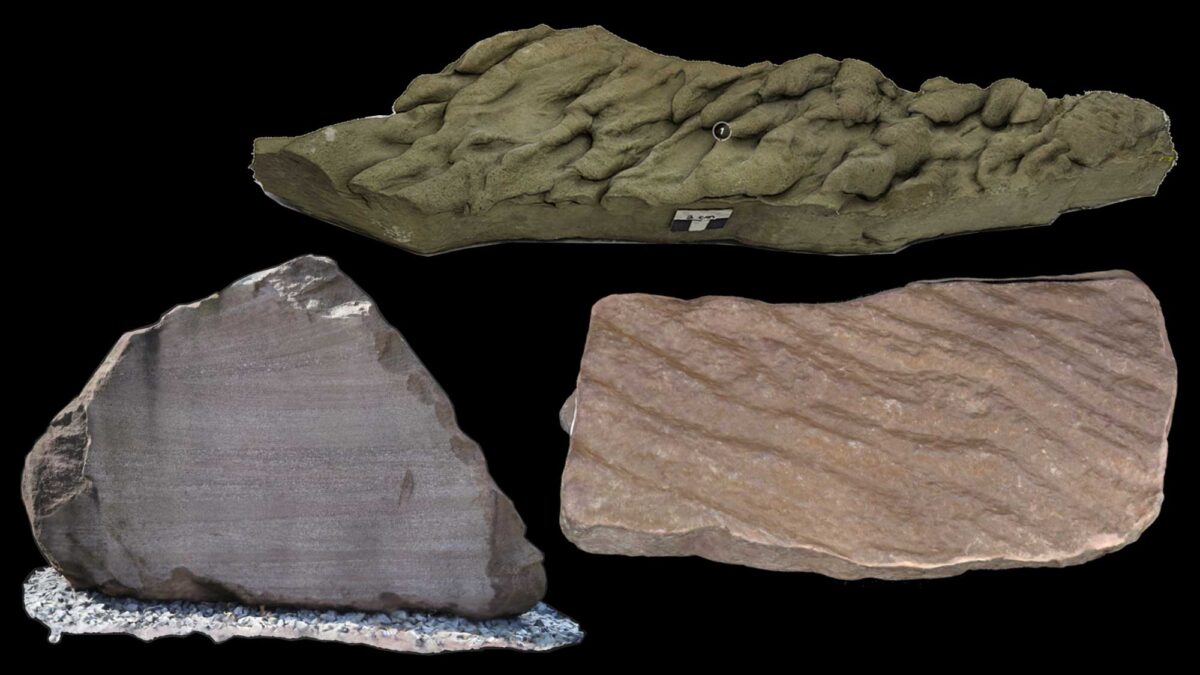Virtual Rock Collection
Igneous Rocks
Sedimentary Rocks
Metamorphic Rocks
Image above: Examples of different types of sedimentary structures. Sources of individual rock images are derived from 3D models on Sketchfab with Creative Commons licensing; see same models below for creator credits and licensing details.
Overview
Sedimentary structures provide evidence of the actions of the physical environment that are preserved in sedimentary rocks. Examples include ripple marks, cross-bedding, fossils uniformly oriented by currents, scours left by objects that were dragged by water flow, mud cracks formed in drying sediments, and even the impressions of raindrops made in ancient soft sediments before they hardened.
Ripple Marks
Locality unknown. Specimen is from the teaching collection of the Paleontological Research Institution, Ithaca, NY. Longest dimension of specimen is approximately 22 cm (Sketchfab; Creative Commons Attribution-ShareAlike 4.0 International license)
Ripple marks. Model by Nate Siddle and the University of Queensland School of Earth Science, Australia (Sketchfab).
Cross-Bedding
Large block of sandstone exhibiting cross-bedding. Block is on display outside of the Museum of the Earth, Ithaca, New York.
Sedimentary rock exhibiting cross-bedding. Model by Nate Siddle and the University of Queensland School of Earth Science, Australia (Sketchfab).
Paleocurrent Indicators
Original caption: "Paleocurrent indicators are primary sedimentary structures which indicate either the flow direction, or axis of the current at the time of sediment deposition. In some cases, clasts (such as pebbles or small cobbles) will be preferentially aligned in such a way that they can serve as indicators of the direction of the current flow (i.e. Imbricated Clasts in conglomerates). In this particular case, Belemnite fossils have been been aligned with the paleocurrent axis. Unfortunately, due to the lack of any obvious imbrication, while the axis of current flow is apparent, the direction of current flow is not." Model by Nate Siddle and the University of Queensland School of Earth Science, Australia (Sketchfab).
Flute Casts
Flute casts. Model by Nate Siddle and the University of Queensland School of Earth Science, Australia (Sketchfab).
Flute casts. Model provided courtesy of Dr. Elisabeth Kosters and shared by Callan Bentley (Sketchfab; Creative Commons Attribution-NonCommercial 4.0 International license).
Original caption: "Flute casts in calcarenite from a turbidite sequence (“Deutenhausener Schichten”, early Oligocene fill of the northern Alpine foreland basin, now deformed). Near Meyersäge, Altenau, Ammertal, Germany. Lat 47˚39‘01’‘N, Lon 10˚59‘58’‘E." Model by Sara Carena (Sketchfab, Creative Commons Attribution 4.0 International license).
Tool Marks
Tool marks. Model by Nate Siddle and the University of Queensland School of Earth Science, Australia (Sketchfab).
Raindrop Impressions
Impressions of raindrops. Model by Nate Siddle and the University of Queensland School of Earth Science, Australia (Sketchfab).



